- 23 - 24 JUILLET
- INDI-UNI : 
PRE-INSCRIPTION : 15 Juin – 15 Août
PRE-REGISTRATION: June 15th - August 15th
- FRANCE – 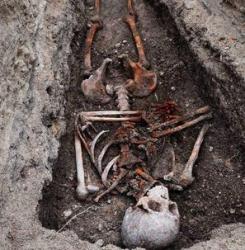
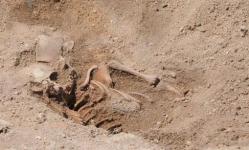 – Montbazon - La troisième campagne de fouilles dans la forteresse du Faucon noir est financée par l'Inrap. Elle est dirigée par Marie-Denise Dalayeun, à la tête d'une équipe de sept chercheurs. Une équipe qui vient de mettre à jour une sépulture d'adulte.
– Montbazon - La troisième campagne de fouilles dans la forteresse du Faucon noir est financée par l'Inrap. Elle est dirigée par Marie-Denise Dalayeun, à la tête d'une équipe de sept chercheurs. Une équipe qui vient de mettre à jour une sépulture d'adulte.
Elle a été trouvée dans le choeur de la chapelle Saint-Georges, mentionnée dans des écrits dès le XIV e siècle. Le dit édifice a été incorporé à un château construit lui au XV e siècle, aujourd'hui démoli. La sépulture était enterrée dans un cercueil, et probablement enveloppée dans un linceul. La procession qui a accompagné le défunt avait laissé un vase à encens déposé sur la tombe. A l'entrée du chevet de la chapelle, une tombe d'enfant a aussi été découverte, situation rare pour l'époque. Il s'agit d'un périnatal enterré dans un linceul avec des épingles. En parallèle, les fouilles des remblais correspondent à la démolition de la chapelle et révèlent un incendie. Au-dessous des remblais du XVI e siècle, d'autres niveaux d'occupation existent, ce qui laisse à penser que le site n'a pas encore dévoilé tous ses secrets. Des campagnes de fouilles seront encore nécessaires et il faut attendre que l'étude des os de la sépulture donne des renseignements plus précis. Jean Guéraud, l'historien local suppose « qu'il s'agit d'un chapelain, car sa tête est tournée vers l'est. Des détails révèlent que le choeur de la chapelle Saint-Georges était surélevé par rapport au dallage de la nef. »
http://www.lanouvellerepublique.fr/indre-et-loire/ACTUALITE/Infos-Departementales/Une-sepulture-d-adulte-mise-a-jour-au-Donjon
- ROYAUME UNI – Bedale - The spotlight is about to fall on buried treasure - found inside the home. Under-floor excavations have taken place at Nunnington Hall, the National Trust property near Helmsley, over recent years. And archaeologist Mark Newman and the Hall’s property team have recovered more than 4,000 objects from under the floorboards in just five rooms of the 17th-century mansion. Ranging from the remains of human meals dragged away by mice to fragments of silk, jewellery and coins, the small treasures combine to paint a rich picture of Nunnington’s life, humdrum and dramatic, over the last 400 years. The finds even include rare 17tth--entury embossed leather wall cladding and secretly hidden papers and particularly touching are the small toys and playing cards obviously "posted" through gaps in the floorboards on rainy afternoons.
http://www.thenorthernecho.co.uk/news/local/bedale/9153065.Spotlight_on_buried_treasure_at_stately_home/
- ROYAUME UNI – 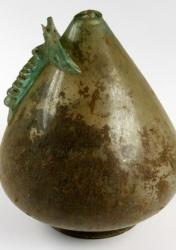 Doncaster - Archaeologists working on the site of Doncaster’s new civic and cultural quarter have unearthed a rare Roman glass jug dating back to around AD150. The area is believed to have been the site of a Roman cemetery where cremations took place. The cremation ceremony appears to have been in use from about AD 140-180. The unearthed vessel, which is 15cm tall and was found close to the site of the new performance venue, would have been filled with rich goods like oils and placed next to a high status burial with the neck of the jug deliberately broken off to be placed in the grave. Doncaster’s Roman history dates back nearly 2,000 years and the town was then known as Danum. A Roman fort was established close to the Market Place near the minster in around AD71.
Doncaster - Archaeologists working on the site of Doncaster’s new civic and cultural quarter have unearthed a rare Roman glass jug dating back to around AD150. The area is believed to have been the site of a Roman cemetery where cremations took place. The cremation ceremony appears to have been in use from about AD 140-180. The unearthed vessel, which is 15cm tall and was found close to the site of the new performance venue, would have been filled with rich goods like oils and placed next to a high status burial with the neck of the jug deliberately broken off to be placed in the grave. Doncaster’s Roman history dates back nearly 2,000 years and the town was then known as Danum. A Roman fort was established close to the Market Place near the minster in around AD71.
http://www.doncasterfreepress.co.uk/community/roman_jug_unearthed_at_site_of_new_theatre_1_3603555
- MALTE – 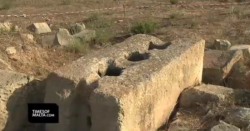 Zejtun - It is midday and the July sun is scorching but none of the archaeologists working in the open field are complaining as they busily unearth the 2,000-year-old past at the site of the former Roman villa in Żejtun. The excavations, that have been going on since 2006, have so far revealed that the site is older than previously thought. “The data will be thoroughly analysed when the excavations terminate. However, at the lower levels we have found Punic pottery, which indicates this was not just a Roman villa. A Phoenician-Punic building, dating to the third century BC, had been there before,” Anthony Bonanno, head at the University’s Archaeology Department, said. This archaeological site, located within the grounds of the St Thomas More Junior Lyceum School for Girls, was first discovered in 1961 during the construction of the school. Subsequent excavations revealed that, in the past, the site had been the location of a thriving olive oil industry and a nearby villa. The villa probably belonged to someone ranking in the “lower-middle class” of society at the time. “There is no mosaic as one would find in a luxury Roman villa, instead the floors are tiled and the walls are plastered with coloured stucco,” Prof. Bonanno said. Other insights into past life are, unfortunately, scarce because the 1960s and 1970s excavations were bereft of crucial documentation. The need to recover data in an attempt to reconstruct the economic and environmental history of the site and its environs has seen the University resuming the Żejtun excavations in 2006. The villa is one of four remaining sites in Malta that date to this period, including the Roman Domus in Rabat, San Pawl Milqi and Ta’ Kaċċatura in Birżebbuġa.
Zejtun - It is midday and the July sun is scorching but none of the archaeologists working in the open field are complaining as they busily unearth the 2,000-year-old past at the site of the former Roman villa in Żejtun. The excavations, that have been going on since 2006, have so far revealed that the site is older than previously thought. “The data will be thoroughly analysed when the excavations terminate. However, at the lower levels we have found Punic pottery, which indicates this was not just a Roman villa. A Phoenician-Punic building, dating to the third century BC, had been there before,” Anthony Bonanno, head at the University’s Archaeology Department, said. This archaeological site, located within the grounds of the St Thomas More Junior Lyceum School for Girls, was first discovered in 1961 during the construction of the school. Subsequent excavations revealed that, in the past, the site had been the location of a thriving olive oil industry and a nearby villa. The villa probably belonged to someone ranking in the “lower-middle class” of society at the time. “There is no mosaic as one would find in a luxury Roman villa, instead the floors are tiled and the walls are plastered with coloured stucco,” Prof. Bonanno said. Other insights into past life are, unfortunately, scarce because the 1960s and 1970s excavations were bereft of crucial documentation. The need to recover data in an attempt to reconstruct the economic and environmental history of the site and its environs has seen the University resuming the Żejtun excavations in 2006. The villa is one of four remaining sites in Malta that date to this period, including the Roman Domus in Rabat, San Pawl Milqi and Ta’ Kaċċatura in Birżebbuġa.
http://www.timesofmalta.com/articles/view/20110723/local/A-dig-into-the-past-at-ejtun.376927
FRANCE – 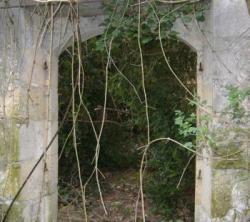 Brusch - Les fouilles archéologiques au lieu dit «Saint-Martin» sur la commune de Bruch ont débuté ce mois-ci. La chapelle Saint-Martin-de-Lauzet est en ruines et se situe aux alentours du XIIIe siècle ; sur le cadastre napoléonien, elle apparaît encore comme édifice religieux. Au début des années 1960, des sondages archéologiques sur l'actuelle propriété ont révélé la présence d'une dizaine de sarcophages d'époque mérovingienne (VIe, VIIe siècle) dont deux ont fourni un riche mobilier funéraire. Fin 2004, un diagnostic archéologique est réalisé. En 2005, l'INRAP (Institut national de recherche en archéologie préventive) confirme la nécropole d'époque mérovingienne par la présence de quatre sarcophages s'organisant autour de murs plus anciens d'époque romaine. Les agents du service régional de l'archéologie ont repéré un massif de maçonnerie indubitablement d'origine antique; cette maçonnerie représente probablement le contrefort situé à l'angle d'un très important bâtiment ; la fonction de celui-ci est pour l'instant inconnue (villa, entrepôt, monument funéraire...). Les dimensions de la maçonnerie conservée: 1,70 m de large pour 4 m de hauteur et l'emprise du ou des bâtiments encore visibles au sol font de ces vestiges un ensemble exceptionnel... C'est dire la qualité des vestiges de Saint-Martin tant en termes d'intérêt scientifique que de son état de conservation... La tâche des fouilles actuelle est donc d'un grand intérêt archéologique.
Brusch - Les fouilles archéologiques au lieu dit «Saint-Martin» sur la commune de Bruch ont débuté ce mois-ci. La chapelle Saint-Martin-de-Lauzet est en ruines et se situe aux alentours du XIIIe siècle ; sur le cadastre napoléonien, elle apparaît encore comme édifice religieux. Au début des années 1960, des sondages archéologiques sur l'actuelle propriété ont révélé la présence d'une dizaine de sarcophages d'époque mérovingienne (VIe, VIIe siècle) dont deux ont fourni un riche mobilier funéraire. Fin 2004, un diagnostic archéologique est réalisé. En 2005, l'INRAP (Institut national de recherche en archéologie préventive) confirme la nécropole d'époque mérovingienne par la présence de quatre sarcophages s'organisant autour de murs plus anciens d'époque romaine. Les agents du service régional de l'archéologie ont repéré un massif de maçonnerie indubitablement d'origine antique; cette maçonnerie représente probablement le contrefort situé à l'angle d'un très important bâtiment ; la fonction de celui-ci est pour l'instant inconnue (villa, entrepôt, monument funéraire...). Les dimensions de la maçonnerie conservée: 1,70 m de large pour 4 m de hauteur et l'emprise du ou des bâtiments encore visibles au sol font de ces vestiges un ensemble exceptionnel... C'est dire la qualité des vestiges de Saint-Martin tant en termes d'intérêt scientifique que de son état de conservation... La tâche des fouilles actuelle est donc d'un grand intérêt archéologique.
http://www.ladepeche.fr/article/2011/07/22/1132507-bruch-des-fouilles-a-saint-martin.html
- ROYAUME UNI – 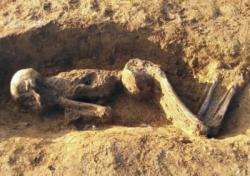 Watton - The remains of a male believed to date back to the Roman occupation of Britain have been discovered in Watton, west Norfolk. The bones were unearthed during work to turn a former RAF base into housing and are thought to have been buried around AD43 to 410. BBC Radio Norfolk's Elizabeth Dawson spoke to site developer Edward Parker and lead archaeologist Mark Holmes to find out more about the discovery.
Watton - The remains of a male believed to date back to the Roman occupation of Britain have been discovered in Watton, west Norfolk. The bones were unearthed during work to turn a former RAF base into housing and are thought to have been buried around AD43 to 410. BBC Radio Norfolk's Elizabeth Dawson spoke to site developer Edward Parker and lead archaeologist Mark Holmes to find out more about the discovery.
VIDEO = http://www.bbc.co.uk/news/uk-england-norfolk-14248492
- ROYAUME UNI – Orkney - Thousands of human bones have been found inside a Stone Age tomb on a northern Scottish island, archaeologists say. The 5,000-year-old burial site in the Orkney Islands came to light when a homeowner dug away a small mound in his yard to improve his ocean view, National Geographic News reported. A camera lowered into a crack between stone slabs making up the tomb's ceiling revealed a prehistoric skull sitting on a pile of muddy bones. "Nobody had known it was an archaeological site before that," Julie Gibson, county archaeologist for Orkney, said. "We have got the assorted remains of many, many people who have been deposited in this tomb at different times," she said. About a thousand skeleton parts belonging to a mix of genders and age groups, including infants, have been unearthed so far. Dubbed the Banks Tomb, it's the first undisturbed Neolithic burial site to be discovered in Scotland in 30 years, Gibson said. The site was first named the Tomb of the Otters when initial excavations revealed prehistoric otter bones among human remains. The animal bones suggest people visited the burial site only sporadically, Gibson said. "It suggests the tomb was not entirely sealed and that otters were trampling in and out a lot" throughout the tomb's use, she said.
http://www.upi.com/Science_News/2011/07/22/Stone-Age-tomb-unearthed-in-Scotland/UPI-16921311369715/#ixzz1Swqk6ObT
- NOUVELLE ZELANDE – 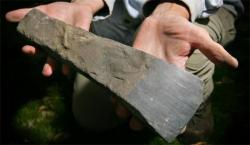 Paremata - The stone adze that archaeologist Pam Chester unearthed in April at Paremata's Ngatitoa Domain near a site believed inhabited since the 15th century. The significance of a Maori adze unearthed in Paremata is still unknown. Archaeologist Pam Chester discovered the adze in April while monitoring earthworks near Para-Plim Rugby Club at Ngatitoa Domain. The 40-centimetre stone adze, now at Te Papa, was notified this week by the Culture and Heritage Ministry. People have 60 days to claim ownership. Determining the age of an artefact could help verify ownership when more than one group laid claim, heritage operations manager Brodie Stubbs said. "That occasionally happens because the country is not tidily divided into agreed iwi and hapu boundaries." Ngati Toa spokeswoman Jennie Smeaton said the iwi would lay claim to the taonga. "As tangata whenua of this rohe we have a responsibility and obligation as kaitiaki [guardians] to look after taonga for the benefit of all. We hope to work closely with any other claimant parties." Nga Tara, Ngati Rangi and Ngati Ira occupied the area before Ngati Toa chief Te Rauparaha arrived in the 1820s. Ms Chester also discovered several earth ovens with fire- cracked cooking stones about 50cm below the rugby pitch. Charcoal samples would help determine the age of the site, believed inhabited from the 15th century.
Paremata - The stone adze that archaeologist Pam Chester unearthed in April at Paremata's Ngatitoa Domain near a site believed inhabited since the 15th century. The significance of a Maori adze unearthed in Paremata is still unknown. Archaeologist Pam Chester discovered the adze in April while monitoring earthworks near Para-Plim Rugby Club at Ngatitoa Domain. The 40-centimetre stone adze, now at Te Papa, was notified this week by the Culture and Heritage Ministry. People have 60 days to claim ownership. Determining the age of an artefact could help verify ownership when more than one group laid claim, heritage operations manager Brodie Stubbs said. "That occasionally happens because the country is not tidily divided into agreed iwi and hapu boundaries." Ngati Toa spokeswoman Jennie Smeaton said the iwi would lay claim to the taonga. "As tangata whenua of this rohe we have a responsibility and obligation as kaitiaki [guardians] to look after taonga for the benefit of all. We hope to work closely with any other claimant parties." Nga Tara, Ngati Rangi and Ngati Ira occupied the area before Ngati Toa chief Te Rauparaha arrived in the 1820s. Ms Chester also discovered several earth ovens with fire- cracked cooking stones about 50cm below the rugby pitch. Charcoal samples would help determine the age of the site, believed inhabited from the 15th century.
http://www.stuff.co.nz/dominion-post/5330872/Ancient-adze-a-mystery